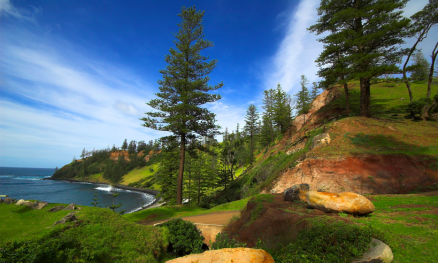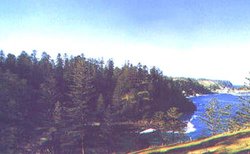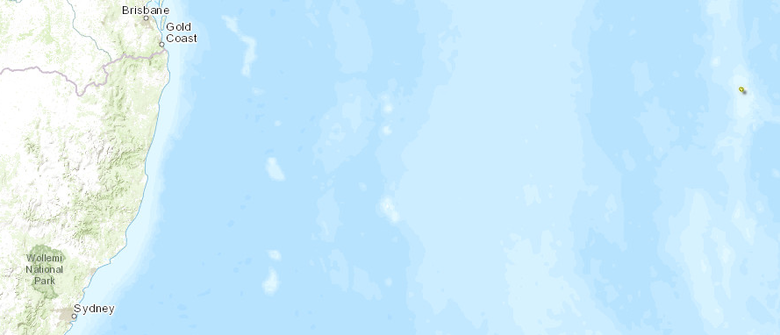Norfolk Island subtropical forests
Introduction Roughly equidistant from New Zealand and New Caledonia, the Norfolk Island group rises from the Pacific Ocean, three small, highly isolated islands. Early settlers found islands covered with mixed-species subtropical rainforest, and inhabited by an abundant and highly endemic avifauna, including the Norfolk Island green parrot (Cyanoramphus novaezelandiae cookii). However, centuries of human habitation led to devastating land clearance and the catastrophic introduction of alien species. The islands’ native biota is now mainly restricted to protected areas. (Norfolk Island subtropical forests)
Location and General Description
The Norfolk Island group is situated on a submarine ridge that runs between New Caledonia and the North Island of New Zealand (29°3' S, 167°58' E). The Norfolk group consists of Norfolk Island, a roughly square island comprising 35 square-kilometers (km2), and two smaller, uninhabited satellite islands, Philip and Nepean Islands. These islands are the only emergent points along the Norfolk Ridge and are therefore quite isolated, approximately 1370 kilometers (km) east of Australia, 680 km south of New Caledonia, and 770 km north of New Zealand. Both Norfolk and Philip Islands are remnants of Pliocene volcanoes. The two islands have eroded substantially since their formation 3 million years ago, although Norfolk Island still has two peaks, Mt. Pitt (316 meters (m)) and Mt. Bates (318 m). In contrast, Nepean Island is a small (1 km2) limestone island with a maximum elevation of 30 m. The Norfolk group has a subtropical climate with a mean annual rainfall of 1357 millimeters (mm) although El Niño events can cause prolonged droughts. Seasonal changes are moderated by the ocean, but winters are distinctly wetter than the rest of the year.
At the time of European discovery in 1774, Norfolk Island was covered almost entirely by mixed-species subtropical rainforest, although the steep cliffs and highest slopes of Mt Pitt supported a distinct community of shrubs, herbs and climbers, dominated by the New Zealand flax (Phormium tenax). All of the floral communities show strong affinities with the flora of New Caledonia and New Zealand. The native rain forest has a diverse angiosperm canopy 20 m to 30 m tall, with an emergent overstory of Norfolk Island pines (Arauacaria heterophylla) up to 60 m tall. The Norfolk Island pine dominates in exposed areas, while moister spots are characterized by endemic palms (Rhopalostylis baueri) and tree-ferns (Cyathea brownii and C. australia). The natural understory is strung thickly with lianas and ferns cover the forest floor. Unfortunately, only one small tract of this forest remains.
Biodiversity Features
Norfolk Island is close enough to other land masses to receive regular vagrants and colonists from across the ocean. However, the Norfolk group is isolated enough that over time, these colonists have evolved into a variety of endemic taxa. The bird and butterfly fauna, as well as the flora, are derived from three distinct sources: Australia, New Zealand, and New Caledonia.
Norfolk Island has 174 native plant species, of which 51 are endemic. Although the well-known Norfolk Island pine is still relatively common, at least 18 other endemic species are now rare or threatened. Like many of the endemic species, the Norfolk Island palm (Rhopalostylis baueri) and the smooth tree-fern (Cyathea brownii) are still common within the Norfolk Island National Park but are now rare elsewhere on the islands. The smooth tree-fern is the tallest tree-fern in the world, occasionally reaching heights of 20 m tall.
Most of the landbirds present at the time of human settlement were endemic taxa. Of the 15 species present at the time, 6 are now extinct, and a number of endemics, including three species and two subspecies, are highly endangered. The Norfolk Island boobook (Ninox novaeseelandiae royana), an endemic owl, was reduced to a single female in 1987 but has since mated successfully with a male New Zealand boobook (Ninox novaeseelandiae), and some of their offspring have also survived and bred. The Australian National Parks and Wildlife Service also runs a captive breeding program for the endangered Norfolk Island green parrot (Cyanoramphus novaezelandiae cookii). There have been no confirmed sightings of the critically endangered white-chested white-eye (Zosterops albogularis) since 1980, but periodic reports indicate that a small population persists in indigenous forest. Although locally common, both the Norfolk Island gerygone (Gerygone modesta) and the slender-billed white-eye (Zosterops tenuirostris) are considered threatened, and the slender-billed white-eye population continues to decline outside protected areas. Two seabirds with restricted breeding ranges, the providence petrel (Pterodroma solandri) and white-necked petrel (P. cervicalis) have been reported breeding on Philip Island. The only native mammal on the islands is Gould's wattled bat (Chalinolobus gouldii) which is locally very rare or possibly extinct.
Current Status
The flora and fauna of the Norfolk group has undergone massive change since human settlement of the islands, and most of the native forests have been lost. Nevertheless, the little that remains is being actively protected and managed by the Australian National Parks and Wildlife Service (ANPWS). There is a lot of restoration that can be done on the islands, and the ANPWS is leading the efforts.
The rich and extensive forests of Norfolk Island have been reduced to a single remnant patch of just 5 km2 in the Mt. Pitt area that was declared a national park in 1986. The forest within the park is fairly intact, albeit infested with several introduced plant species. A few small tracts of clifftop and coastal vegetation are protected by a series of reserves. The rest of the island, which was once almost entirely forested, has been cleared for agriculture, cattle pastures and houses. In summary, the main floral communities are all represented within the reserve and park system, but the patches that exist are extremely small.
Types and Severity of Threats
Land clearance and introduced species have devastated the flora and fauna of the Norfolk islands. The forests have been logged and cleared for pasture and while some Norfolk Island pines and Lagunaria patersonia trees persist in the pastures, there is no regeneration due to grazing pressure. Introduced weeds have displaced native flora in some areas- by the 1960s, there were already 244 introduced plants on Norfolk Island, as compared to the 174 native species. Endemic bird species that relied on the rain forest have declined precipitously. The Norfolk Island Green Parrot was once so numerous that the convict settlers had to beat parrots off their crops with sticks, but was reduced to only 16 individuals in 1983.
Nepean Island and Philip Island were even harder hit by introduced species. Philip Island once supported a lush rain forest, but it was almost completely denuded by introduced goats, pigs and rabbits. By the mid-1980s, when these species were finally eradicated, the only remaining vegetation was a clump of hibiscus, a few Lagunaria patersonia trees, and a few weeds. Most of the topsoil had eroded away, and the freshwater streams were dry. Restoration efforts are currently underway on the island, and it is now a National Park. Nepean Island had similar problems with rabbits: almost all of the herbaceous vegetation was eaten, and all of the Norfolk Island pines have died.
Justification of Ecoregion Delineation
he Norfolk Island Subtropical Forests includes the ‘Norfolk Island’ 'Endemic Bird Area' (EBA) and contains part of the ‘Norfolk and Lord Howe Islands’ Centre of Plant Diversity.
Additional information on this ecoregion
- For a shorter summary of this entry, see the WWF WildWorld profile of this ecoregion.
- To see the species that live in this ecoregion, including images and threat levels, see the WWF Wildfinder description of this ecoregion.
- World Wildlife Fund Homepage
Further Reading
- BirdLife International. 2000. Threatened Birds of the World. Lynx Edicions and BirdLife International. Barcelona and Cambridge, UK. ISBN: 0946888396
- Boden, R. 1995. Norfolk and Lord Howe Islands. Pages 476 – 479 in S. D. Davis, V. H. Heywood and A. C. Hamilton. editors. Centres of Plant Diversity. Volume 2. Asia, Australasia, and the Pacific. WWF/IUCN, IUCN Publications Unit, Cambridge, UK.
- Holloway, J.D. 1996. The Lepidoptera of Norfolk Island, actual and potential, their origins and dynamics. Pages 123-150 in A. Keast and S.E. Miller, editors. The origin and evolution of Pacific island biotas, New Guinea to eastern Polynesia: patterns and processes. SPB Academic Publishing, The Netherlands. ISBN: 905103136X
- Keast, A. 1996. Avian geography: New Guinea to the eastern Pacific. Pages 373-398. in A. Keast and S.E. Miller, editors. The origin and evolution of Pacific island biotas, New Guinea to eastern Polynesia: patterns and processes. SPB Academic Publishing, The Netherlands. ISBN: 905103136X
- Mueller-Dombois, D., and F.R. Forsberg. 1998. Vegetation of the tropical Pacific islands. Springer-Verlag, New York, Inc. ISBN: 038798285X
- Olsen, P.D. 1996. Re-establishment of an endangered subspecies: The Norfolk Island Boobook owl Ninox novaeseelandiae undulata. Bird Conservation International 6(1): 63-80.
- Stattersfield, A.J., M.J. Crosby, A.J. Long, and D.C. Wedge. 1998. Endemic bird areas of the World. Priorities for biodiversity conservation. BirdLife Conservation Series No. 7. BirdLife International, Cambridge, United Kingdom.
- Turner, J.S. C.N. Smithers, and R.D. Hoogland. 1968. The conservation of Norfolk Island. Australian Conservation Foundation, Spec. Publ. 1, Melbourne.
| Disclaimer: This article is taken wholly from, or contains information that was originally published by, the World Wildlife Fund. Topic editors and authors for the Encyclopedia of Earth may have edited its content or added new information. The use of information from the World Wildlife Fund should not be construed as support for or endorsement by that organization for any new information added by EoE personnel, or for any editing of the original content. |


